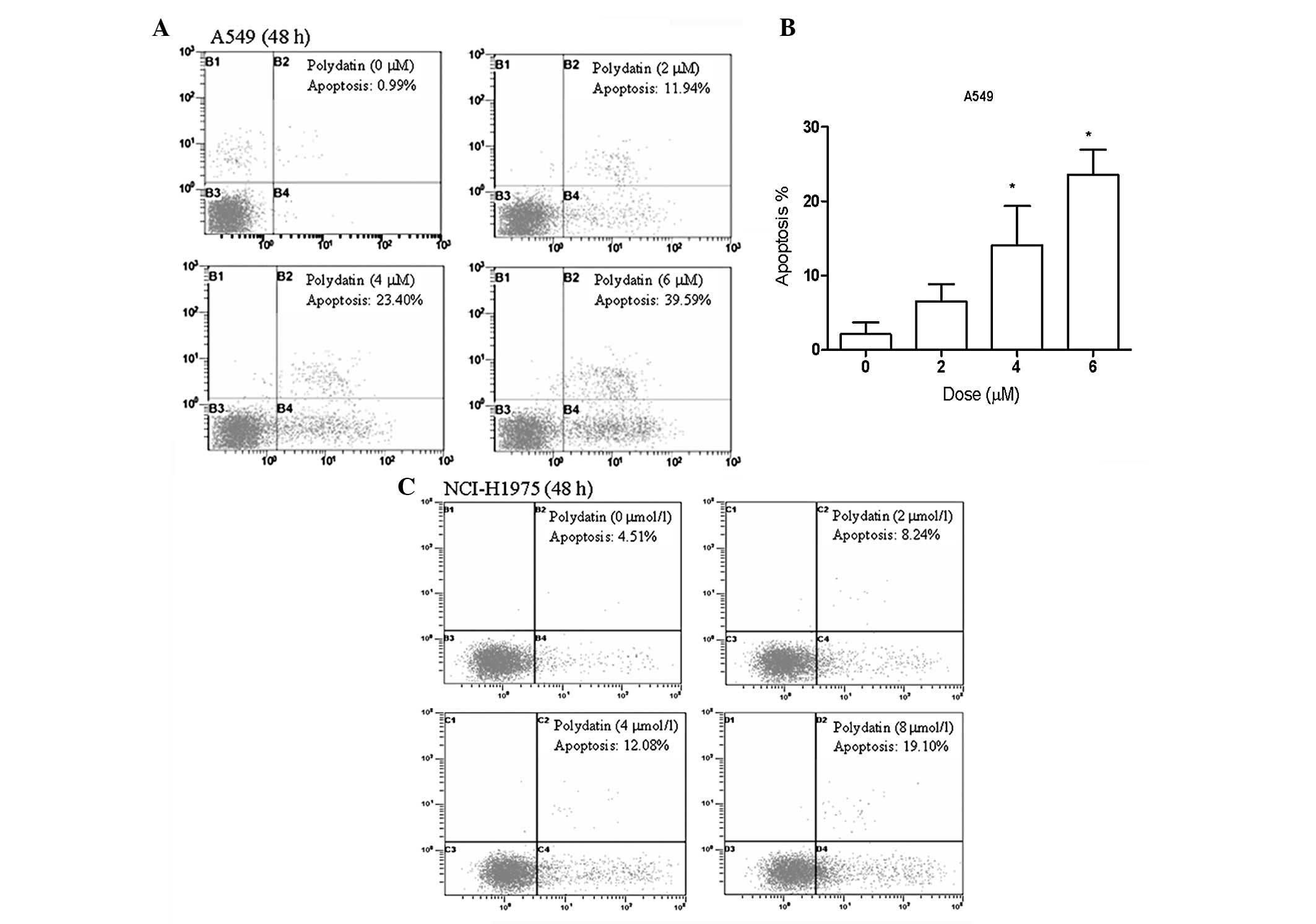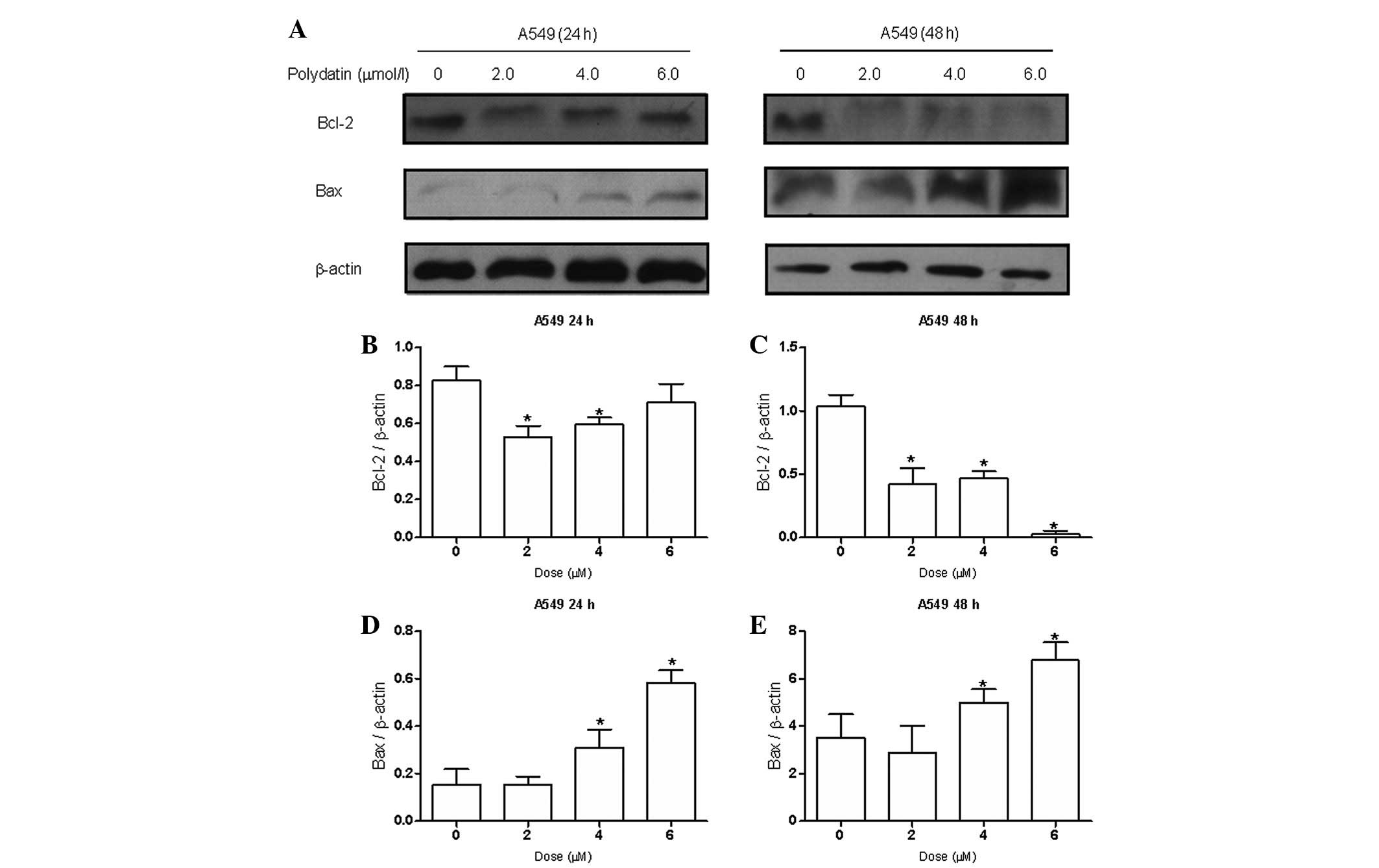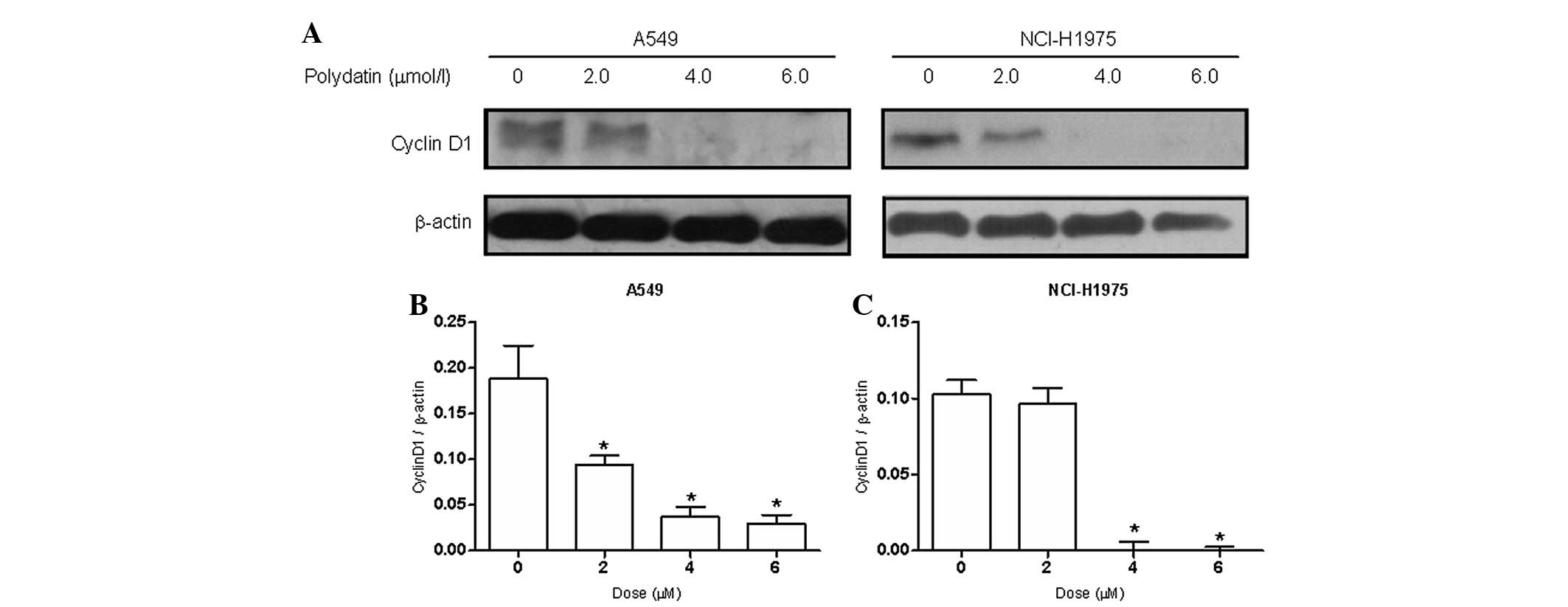|
1
|
Spiro SG, Tanner NT, Silvestri GA, et al:
Lung cancer: progress in diagnosis, staging and therapy.
Respirology. 15:44–50. 2010. View Article : Google Scholar : PubMed/NCBI
|
|
2
|
Stinchcombe TE, Fried D, Morris DE and
Socinski MA: Combined modality therapy for stage III non-small cell
lung cancer. Oncologist. 11:809–823. 2006. View Article : Google Scholar : PubMed/NCBI
|
|
3
|
Luan J, Duan H, Liu Q, Yagasaki K and
Zhang G: Inhibitory effects of norcantharidin against human lung
cancer cell growth and migration. Cytotechnology. 62:349–355. 2010.
View Article : Google Scholar : PubMed/NCBI
|
|
4
|
Newman DJ and Cragg GM: Natural products
as sources of new drugs over the last 25 years. J Nat Prod.
70:461–477. 2007.PubMed/NCBI
|
|
5
|
Cragg GM and Newman DJ: Plants as a source
of anti-cancer agents. J Ethnopharmacol. 100:72–79. 2005.
|
|
6
|
Gordaliza M: Natural products as leads to
anticancer drugs. Clin Transl Oncol. 9:767–776. 2007. View Article : Google Scholar : PubMed/NCBI
|
|
7
|
Zhao KS, Jin C, Huang X, et al: The
mechanism of Polydatin in shock treatment. Clin Hemorheol
Microcirc. 29:211–217. 2003.PubMed/NCBI
|
|
8
|
Wang X, Song R, Chen Y, Zhao M and Zhao
KS: Polydatin - a new mitochondria protector for acute severe
hemorrhagic shock treatment. Expert Opin Investig Drugs.
22:169–179. 2013. View Article : Google Scholar : PubMed/NCBI
|
|
9
|
Wang X, Song R, Bian HN, Brunk UT, Zhao M
and Zhao KS: Polydatin, a natural polyphenol, protects arterial
smooth muscle cells against mitochondrial dysfunction and lysosomal
destabilization following hemorrhagic shock. Am J Physiol Regul
Integr Comp Physiol. 302:R805–R814. 2012. View Article : Google Scholar
|
|
10
|
Cheng Y, Zhang HT, Sun L, et al:
Involvement of cell adhesion molecules in polydatin protection of
brain tissues from ischemia-reperfusion injury. Brain Res.
1110:193–200. 2006. View Article : Google Scholar : PubMed/NCBI
|
|
11
|
Miao Q, Wang S, Miao S, Wang J, Xie Y and
Yang Q: Cardioprotective effect of polydatin against
ischemia/reperfusion injury: roles of protein kinase C and mito
K(ATP) activation. Phytomedicine. 19:8–12. 2011. View Article : Google Scholar : PubMed/NCBI
|
|
12
|
Gao JP, Chen CX, Gu WL, Wu Q, Wang Y and
Lü J: Effects of polydatin on attenuating ventricular remodeling in
isoproterenol-induced mouse and pressure-overload rat models.
Fitoterapia. 81:953–960. 2010. View Article : Google Scholar : PubMed/NCBI
|
|
13
|
Indraccolo U and Barbieri F: Effect of
palmitoylethanolamide-polydatin combination on chronic pelvic pain
associated with endometriosis: preliminary observations. Eur J
Obstet Gynecol Reprod Biol. 150:76–79. 2010. View Article : Google Scholar
|
|
14
|
Fan S, Wang JA, Yuan RQ, et al: BRCA1 as a
potential human prostate tumor suppressor: modulation of
proliferation, damage responses and expression of cell regulatory
proteins. Oncogene. 16:3069–3082. 1998. View Article : Google Scholar
|
|
15
|
Vermes I, Haanen C, Steffens-Nakken H and
Reutelingsperger C: A novel assay for apoptosis. Flow cytometric
detection of phosphatidylserine expression on early apoptotic cells
using fluorescein labelled Annexin V. J Immunol Methods. 184:39–51.
1995. View Article : Google Scholar
|
|
16
|
Fan S, Gao M, Meng Q, et al: Role of
NF-kappaB signaling in hepatocyte growth factor/scatter
factor-mediated cell protection. Oncogene. 24:1749–1766. 2005.
View Article : Google Scholar : PubMed/NCBI
|
|
17
|
Xu JY, Meng QH, Chong Y, et al:
Sanguinarine inhibits growth of human cervical cancer cells through
the induction of apoptosis. Oncol Rep. 28:2264–2270.
2012.PubMed/NCBI
|
|
18
|
Hollman PC, de Vries JH, van LSD,
Mengelers MJ and Katan MB: Absorption of dietary quercetin
glycosides and quercetin in healthy ileostomy volunteers. Am J Clin
Nutr. 62:1276–1282. 1995.PubMed/NCBI
|
|
19
|
Paganga G and Rice-Evans CA: The
identification of flavonoids as glycosides in human plasma. FEBS
Lett. 401:78–82. 1997. View Article : Google Scholar : PubMed/NCBI
|
|
20
|
Regev-Shoshani G, Shoseyov O, Bilkis I and
Kerem Z: Glycosylation of resveratrol protects it from enzymic
oxidation. Biochem J. 374:157–163. 2003. View Article : Google Scholar : PubMed/NCBI
|
|
21
|
Krasnow MN and Murphy TM: Polyphenol
glucosylating activity in cell suspensions of grape (Vitis
vinifera). J Agric Food Chem. 52:3467–3472. 2004. View Article : Google Scholar : PubMed/NCBI
|
|
22
|
Jang M, Cai L, Udeani GO, et al: Cancer
chemopreventive activity of resveratrol, a natural product derived
from grapes. Science. 275:218–220. 1997. View Article : Google Scholar : PubMed/NCBI
|
|
23
|
Joe AK, Liu H, Suzui M, Vural ME, Xiao D
and Weinstein IB: Resveratrol induces growth inhibition, S-phase
arrest, apoptosis, and changes in biomarker expression in several
human cancer cell lines. Clin Cancer Res. 8:893–903. 2002.
|
|
24
|
Rezk YA, Balulad SS, Keller RS and Bennett
JA: Use of resveratrol to improve the effectiveness of cisplatin
and doxorubicin: study in human gynecologic cancer cell lines and
in rodent heart. Am J Obstet Gynecol. 194:e23–e26. 2006. View Article : Google Scholar : PubMed/NCBI
|
|
25
|
Liu PL, Tsai JR, Charles AL, et al:
Resveratrol inhibits human lung adenocarcinoma cell metastasis by
suppressing heme oxygenase 1-mediated nuclear factor-kappaB pathway
and subsequently downregulating expression of matrix
metalloproteinases. Mol Nutr Food Res. 54(Suppl 2): S196–S204.
2010. View Article : Google Scholar
|
|
26
|
Shibata MA, Akao Y, Shibata E, et al:
Vaticanol C, a novel resveratrol tetramer, reduces lymph node and
lung metastases of mouse mammary carcinoma carrying p53 mutation.
Cancer Chemother Pharmacol. 60:681–691. 2007. View Article : Google Scholar
|
|
27
|
Liu HS, Pan CE, Yang W and Liu XM:
Antitumor and immunomodulatory activity of resveratrol on
experimentally implanted tumor of H22 in Balb/c mice. World J
Gastroenterol. 9:1474–1476. 2003.PubMed/NCBI
|
|
28
|
Zhou HB, Chen JJ, Wang WX, Cai JT and Du
Q: Anticancer activity of resveratrol on implanted human primary
gastric carcinoma cells in nude mice. World J Gastroenterol.
11:280–284. 2005. View Article : Google Scholar : PubMed/NCBI
|
|
29
|
Pan MH, Gao JH, Lai CS, et al: Antitumor
activity of 3,5,4′-trimethoxystilbene in COLO 205 cells and
xenografts in SCID mice. Mol Carcinog. 47:184–196. 2008.
|
|
30
|
Li T, Fan GX, Wang W, Li T and Yuan YK:
Resveratrol induces apoptosis, influences IL-6 and exerts
immunomodulatory effect on mouse lymphocytic leukemia both in vitro
and in vivo. Int Immunopharmacol. 7:1221–1231. 2007. View Article : Google Scholar
|
|
31
|
Chen JC, Chen Y, Lin JH, Wu JM and Tseng
SH: Resveratrol suppresses angiogenesis in gliomas: evaluation by
color Doppler ultrasound. Anticancer Res. 26:1237–1245.
2006.PubMed/NCBI
|
|
32
|
Wyllie AH: Apoptosis: an overview. Br Med
Bull. 53:451–465. 1997. View Article : Google Scholar
|
|
33
|
Neto CC, Amoroso JW and Liberty AM:
Anticancer activities of cranberry phytochemicals: an update. Mol
Nutr Food Res. 52(Suppl 1): S18–S27. 2008.PubMed/NCBI
|
|
34
|
Kaur M and Agarwal R: Transcription
factors: molecular targets for prostate cancer intervention by
phytochemicals. Curr Cancer Drug Targets. 7:355–367. 2007.
View Article : Google Scholar : PubMed/NCBI
|
|
35
|
Yang J, Liu X, Bhalla K, et al: Prevention
of apoptosis by Bcl-2: release of cytochrome c from mitochondria
blocked. Science. 275:1129–1132. 1997. View Article : Google Scholar : PubMed/NCBI
|
|
36
|
Kluck RM, Bossy-Wetzel E, Green DR and
Newmeyer DD: The release of cytochrome c from mitochondria: a
primary site for Bcl-2 regulation of apoptosis. Science.
275:1132–1136. 1997. View Article : Google Scholar : PubMed/NCBI
|
|
37
|
Graña X and Reddy EP: Cell cycle control
in mammalian cells: role of cyclins, cyclin dependent kinases
(CDKs), growth suppressor genes and cyclin-dependent kinase
inhibitors (CKIs). Oncogene. 11:211–219. 1995.PubMed/NCBI
|
|
38
|
Pavletich NP: Mechanisms of
cyclin-dependent kinase regulation: structures of Cdks, their
cyclin activators, and Cip and INK4 inhibitors. J Mol Biol.
287:821–828. 1999. View Article : Google Scholar : PubMed/NCBI
|
|
39
|
Alao JP: The regulation of cyclin D1
degradation: roles in cancer development and the potential for
therapeutic invention. Mol Cancer. 6:242007. View Article : Google Scholar : PubMed/NCBI
|
|
40
|
Gillett C, Smith P, Gregory W, et al:
Cyclin D1 and prognosis in human breast cancer. Int J Cancer.
69:92–99. 1996. View Article : Google Scholar : PubMed/NCBI
|
|
41
|
Hall M and Peters G: Genetic alterations
of cyclins, cyclin-dependent kinases, and Cdk inhibitors in human
cancer. Adv Cancer Res. 68:67–108. 1996. View Article : Google Scholar : PubMed/NCBI
|
|
42
|
Molenaar JJ, Ebus ME, Koster J, et al:
Cyclin D1 and CDK4 activity contribute to the undifferentiated
phenotype in neuroblastoma. Cancer Res. 68:2599–2609. 2008.
View Article : Google Scholar : PubMed/NCBI
|
|
43
|
Yang K, Hitomi M and Stacey DW: Variations
in cyclin D1 levels through the cell cycle determine the
proliferative fate of a cell. Cell Div. 1:322006. View Article : Google Scholar : PubMed/NCBI
|















